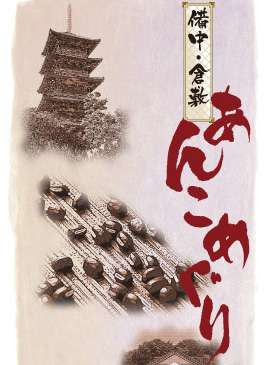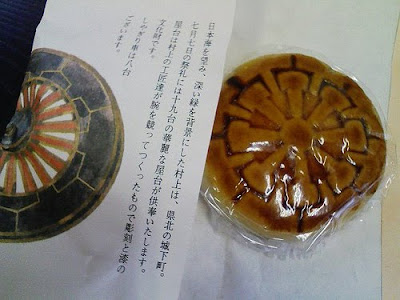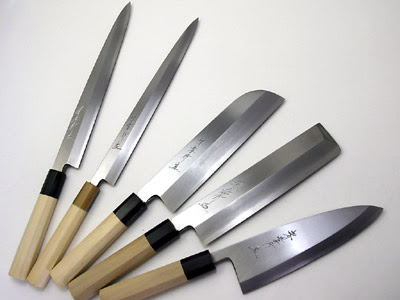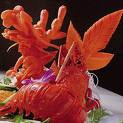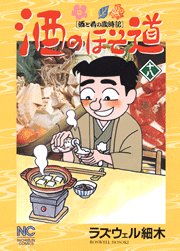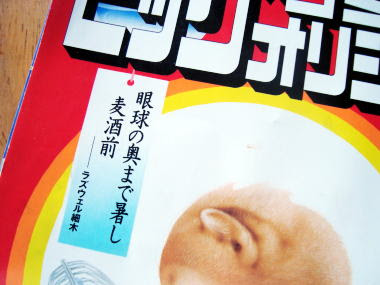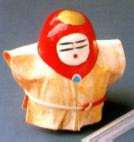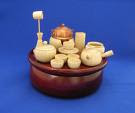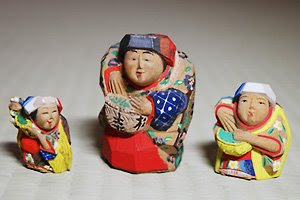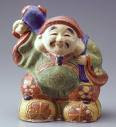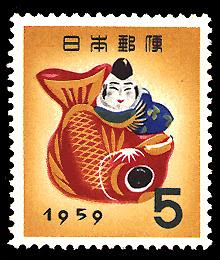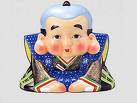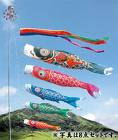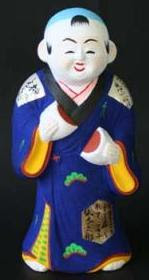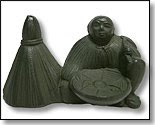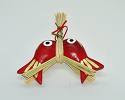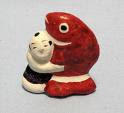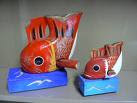[ . BACK to WORLDKIGO TOP . ]
::::::::::::::::::::::::::::::::::::::::::::::::::::::::::::::::::::::::::::::::::::::::::::::::::::
The
UTSUWA うつわ【器】, vessel or dish
in which the food is served, is as much of importance to washoku as is the cooking itself.
Rosanjin was known for making his own pottery vessels to fit his food.
He even made some dishes with Japanese poetry inscriptions.
 © PHOTO :utahito takakiyo
© PHOTO :utahito takakiyo
Most famous restaurants have a separate
... Storehouse, warehouse (kura, dozoo) ... , where they keep different dishes for all seasons, sometimes different one's for every month.
When I learned kaiseki cooking in Kamakura, my teacher had different dishes for every month and some extra for special monthly celebrations like the Boy's Festival or Chrysanthemum Watching.
Here I want to introduce an important person of Japan, whith a great influence on the UTSUWA culture.
::::::::::::::::::::::::::::::::::::::::::::::::::::::::::::::::::::::::::::::::::::::::::::::::::::
Kitaoji Rosanjin (北大路魯山人)
(1883 – 1959)
Kitaooji Rosanjin
a calligrapher, ceramicist and restaurateur in Japan during the first half of the twentieth century. Born in the village of Kamigano he founded the
Bishoku Club (Gourmet's Club) in 1921. It became a private restaurant. The Great Tokyo earthquake of 1923 destroyed most of his ceramics collection, and he began making pottery to replace it. He also became a scholar of antique pottery publishing his work during the 1930's. Isamu Noguchi lived on his property for a while during the 1950s.
Rosanjin was mentioned several times on the Japanese TV show Iron
Chef as the "mentor" of the "Chairman Kaga" character.
Kaiseki Chef, Yasushi Naoe (born in Oono, Kanazawa, Ishikawa Prefecture, Japan in 1935) used Rosanjin's museum dishes for very special occasions at Kawai Ryokan in Toyama, Japan.
© More in the WIKIPEDIA !
! Photos !

::::::::::::::::::::::::::::::::::::::::::::::::::::::::::::::::::::::::::::::::::::::::::::::::::::
Mountain man who walked the path of art
"Born alone, will die alone;
come alone, will be gone alone;
study alone, walk alone."
This is said to be the mantra of one of Japan's greatest 20th-century artists, the boisterous, arrogant and brilliant Rosanjin Kitaoji.
MORE
source : www.e-yakimono.net / Robert Yellin
External LINS about Rosanjin
http://shofu.pref.ishikawa.jp/portal/syoku-e/culture/rosanjin/index.html
::::::::::::::::::::::::::::::::::::::::::::::::::::::::::::::::::::::::::::::::::::::::::::::::::::

Wa no Utsuwa, 和の器 Japanese Vessels
wafuu ustuwa 和風器 Japanese plates and dishes
yooki 容器 container, vessel
Gefäß; Behälter
::::::::::::::::::::::::::::::::::::::::::::::::::::::::::::::::::::::::::::::::::::::::::::::::::::
various kinds of plates and bowls
Teller, Schale, Schüssel
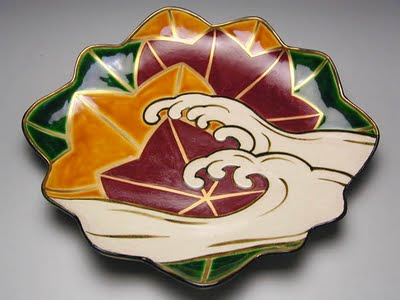 sara, ban さら 【皿・盤】 plate, dish, saucer, platter
sara, ban さら 【皿・盤】 plate, dish, saucer, platter
ashizuki kaku daizara 足付角大皿 large square plate with small legs (for kaiseki meals)
daenkei torizara 楕円取り皿 oblong plater (for indivitual helpings)
fukazara 深皿 dish (deep plate)]
hassunzara, hassun sara 八寸皿 Hassun-plate for kaiseki (about 24 cm long)
. . . CLICK here for Photos !
haizara はいざら【灰皿】 ash tray (Aschenbecher)
hiratai 平たい皿 flat dish/ plate
hirazara ひらざら【平皿】 flat dish. flache Platte, flacher Teller
kakunagazara 角長皿 long square plate. lange viereckige Platte
. . . CLICK here for Photos !
kareezara カレー皿 plate for curry rice. usually oblong and rather deep.
. . . CLICK here for Photos !
kashizara 菓子皿 plate for sweets
kakuzara かくざら【角皿】 plate with four corners. viereckige Platte, viereckiger Teller
. . . CLICK here for Photos !
kozara 小皿 small plate . kleiner Teller, kleine Schüssel
nagakakuzara 長角皿 square long plate (for grilled fish)
oogi hirazara 扇平皿 flat dish in the shape of a handfan
. . . CLICK here for Photos !
oozara 大皿 platter. großer Teller, große Schüssel
pureeto プレート plate (western style)
sakanazara, sakana sara 魚皿 plate for a fish, often with a fish pattern or itself in the form of a fish
. . . CLICK here for Photos !

sashimizara, sashimi sara 刺身皿 plate for sashimi, often with a small extra dish for the sauce.
sankakuzara 三角皿 plate with three corners
. . . CLICK here for Photos !
shikakuzara 四角皿 square plate
soosaa ソーサー saucer, western-style plate
sushizara, sushi sara 寿司皿 plate for sushi, sometimes with a cover for a kaiten zushi.
. . . CLICK here for Photos !
suupuzara スープ皿 soup plate
teshiozara 手塩皿 small plate for table salt
torizara 取り皿 small plate (for your individual helping). kleiner Teller, um Essen für alle zu verteilen
. . . CLICK here for Photos !
ukezara 受け皿 saucer (also used for flower pots). Untertasse
. . . CLICK here for Photos !
ukezaratsuki kappu 受け皿つきカップ cup with saucer. Tasse mit Untertasse

saramawashi さらまわし【皿回し】
spinning plates on a stick
Tellerjonglieren
..........................................
hachi はち【鉢】 bowls of all kinds
asabachi 浅鉢 shallow bowl. flache Schale
chawan 茶碗 ricebowl. lit. "tea cup". Reisschale, Schüssel
chuubachi 中鉢 bowl of middle size
daenbachi, daen hachi 楕円鉢 oblong bowl
daibachi 大鉢 big bowl. grosse Schale
donburi どんぶり【丼】 bowl, usually with a lid of the same pattern. Donburi-Schüssel
donabe 土鍋 earthware pot. irdener Kochtopf
futatsuki wan 蓋付き碗 bowl with a lid (often for chawan mushi)
fukabachi 深鉢 deep bowl. tiefe Schale
guratan sarabachi グラタン皿鉢 bowl for gratin (usually heat-proof)
kakubachi 角鉢 square bowl. viereckige Schale
. . . CLICK here for Photos !
katakuchi bachi 片口鉢 bowl with a spout on one side. Schale mit Ausguss an einer Seite
. . . CLICK here for Photos !
kobachi 小鉢 small bowl. kleine Schale
mamebachi 豆鉢 very small bowl
meshiwan めしわん【飯椀/飯碗】 bowl for rice. Reisschale
sankaku asabachi 三角浅鉢 shallow bowl with three corners
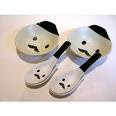
tonsui とんすい small bowl with a handle (to take your own portions from a larger pot)
. . . CLICK here for Photos !
..... tetsuke tonsui 手付とんすい with a handle. Portionsschale.
It often comes with a small saucer
.................................................................................
kigo for all summer
. suzu no hachi 錫の鉢 (すずのはち) small pot of tin
suzu no sara 錫の皿(すずのさら)plate of tin
. kiriko 切子(きりこ)cut glass
..... kattogurasu カットグラス
..... gyaman ギヤマン (diamant)
..... biidoro びいどろ (vidro)
For small pots and plates, glasses and more
.................................................................................
WASHOKU
sawachi ryori 皿鉢料理 Ceremonial Food from Tosa.
Festessen von Tosa
"lit. food served on plates and bowls
..........................................
cups : kappu カップ cup
chawan 茶碗 tea cup for the tea ceremony. Teetasse
guinomi ぐい呑, ぐい飲み extra large sake cup. großer Sakebecher
koohii kappu コーヒーカップ coffee cup. Kaffeetasse
sakazuki 杯/ さかずき small cup for hot sake. Trinkschale für Reiswein; Sakeschälchen
tei kappu, tii kappu テイーカップ tea cup. Teetasse fuer schwarzen Tee
tii kappu チーカップ tea cup (not very commonly uses)
yunomi 湯のみ(湯呑み) small tea cups. Becher, meist fuer Tee.
(lit. drinking hot water)
. . . CLICK here for yunomi Photos !
. Teacups 湯のみ yunomi with Daruma .
:::::::::::::::::::::::::::::::::::::::::::::::::::::::::::::::::::::::::::::::::::::::::::::::::::
Compiled by Larry Bole
Kigo Hotline, February 2012
sarabachi mo honoka ni yami no yoisuzumi
--Basho
plates and bowls too
faint in twilight:
evening cool
Tr. Barnhill
plates and bowls
dimly in the darkness
evening cool
Tr. Reichhold
plates and bowls
dim in the twilight--
the evening cool
Tr. Ueda
sara o fumu nezumi no oto no samusa kana
--Buson
Treading on the dishes,
rats make a noise
of coldness!
Tr. Sawa & Shiffert
The sound
Of a rat on a plate,--
How cold it is!
Tr. Blyth
akikaze ya moyoo no chigau sara futatsu
-- Sekitei Hara (1889-1951)
autumn wind--
with different patterns
two plates
Tr. Ueda
shirasara no fureau oto no yoru no aki
--Yoshiko Yoshino
the sound of white plates
clinking together--
a night in autumn
Tr. Ueda
mo no ie no mashiroki sara no mugetsu kana
--Yoshiko Yoshino
The pure white dishes
of a house in mourning--
harvest moon unseen
Tr. Gurga & Miyashita
:::::::::::::::::::::::::::::::::::::::::::::::::::::::::::::::::::::::::::::::::::::::::::::::::::
 source : facebook
セルヴィス・ランベール 「平皿 海老に鯛図」
source : facebook
セルヴィス・ランベール 「平皿 海老に鯛図」
Homage to Hokusai and Hiroshige 北斎、広重へのオマージュ
My Articles on Japanese Pottery
start from here:
Yakimono 焼物 Daruma in and on pottery
WASHOKU ... Tableware and Tools
:::::::::::::::::::::::::::::::::::::::::::::::::::::::::::::::::::::::::::::::::::::::::::::::::::::::::::::::::::::::::::
[ . BACK to DARUMA MUSEUM TOP . ]
[ . BACK to WORLDKIGO . TOP . ]
:::::::::::::::::::::::::::::::::::::::::::::::::::::::::::::::::::::::::::::::::::::::::::::::::::::::::::::::::::::::::::
